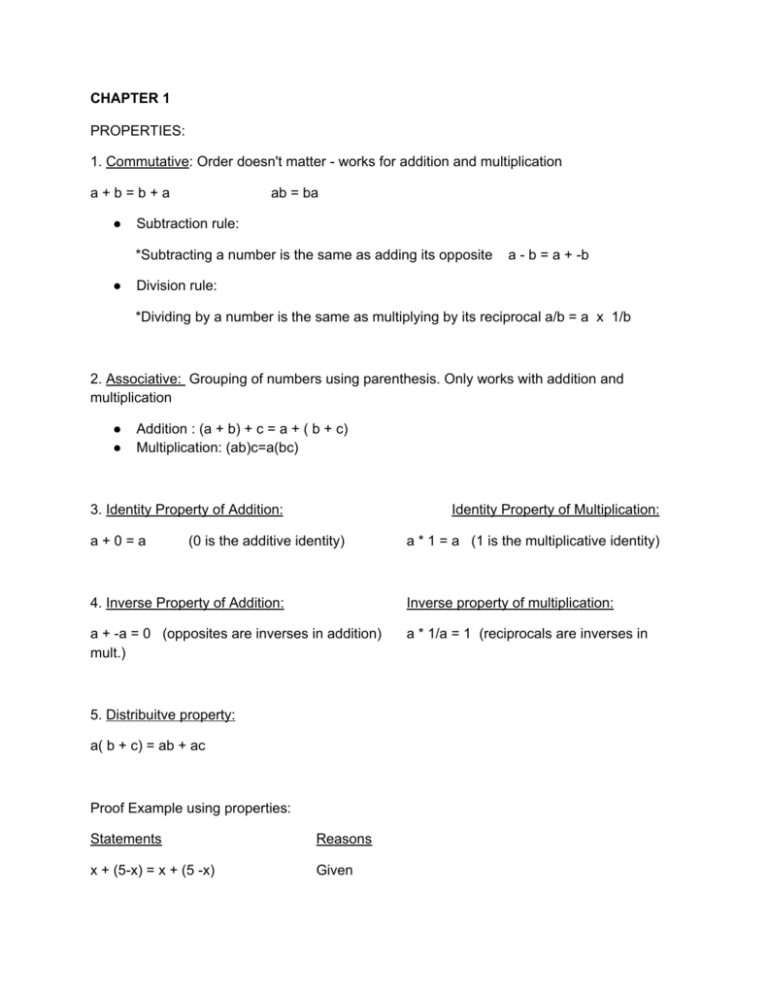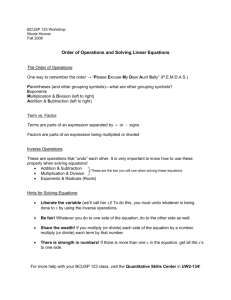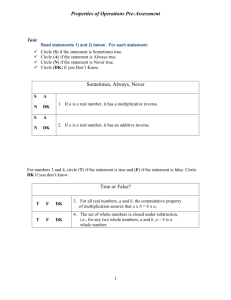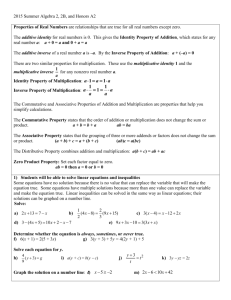CHAPTER 1 PROPERTIES: 1. Commutative: Order doesn`t
advertisement

CHAPTER 1 PROPERTIES: 1. Commutative: Order doesn't matter ­ works for addition and multiplication a + b = b + a ● ab = ba Subtraction rule: *Subtracting a number is the same as adding its opposite a ­ b = a + ­b ● Division rule: *Dividing by a number is the same as multiplying by its reciprocal a/b = a x 1/b 2. Associative: Grouping of numbers using parenthesis. Only works with addition and multiplication ● ● Addition : (a + b) + c = a + ( b + c) Multiplication: (ab)c=a(bc) 3. Identity Property of Addition: a + 0 = a Identity Property of Multiplication: (0 is the additive identity) a * 1 = a (1 is the multiplicative identity) 4. Inverse Property of Addition: Inverse property of multiplication: a + ­a = 0 (opposites are inverses in addition) mult.) a * 1/a = 1 (reciprocals are inverses in 5. Distribuitve property: a( b + c) = ab + ac Proof Example using properties: Statements Reasons x + (5­x) = x + (5 ­x) Given x + (5­x) = x + ( 5 + ­x) Subtraction Rule x + (5 ­x) = x + ( ­x +5) Commutative Property x + (5 ­x) = (x + ­x ) + 5 Associative Property of addition x + (5­x) = 0 + 5 Inverse Property of addition x + (5­x) = 5 Identity Property Unit Analysis: • Take words out, write #s with units. • Determine what final answer needs to be in. ex. Ft/sec, mile/hr. • Use conversion factors to balance units. • Cross out labels, keep #s. • Flip fractions in order cross cancel labels. • Multiply straight across. 50 mile 5280 feet 1 hour = 50 x 5280 = 73.3 ft/sec. 1 hour 1 mile 3600 sec 3600 Simplify: • Distribute • Combine like terms • Answer is an expression • No equal sign • Ex. 2 ( 3x – 1) + 4x – 15 à 10x – 17 Evaluate: • Plug x into expression if given • When using a negative number, you must put it in ( ). • Ex. 2 ( 3x – 1) + 4x – 15 when x = ­2 à answer is ­37. ● Put numerator and denominators in their own sets of ( ). Order of operations: • Paranthesis • Exponents • Multiplication • Division • Addition • Subtraction Steps for solving equations: • Simplify both sides of =. • Get x terms to one side, #s to the other. ( adding or subtracting) • Get x alone. ( multiply or divide) • Check your answer in original equation. Literal equations: • Solve problems for specific variable • Do opposite, to get new variable alone • Ex. D = m/v solve for m. M = dv *S = 2lw + 2wh + 2lh Solve for w. Strategies for problem solving: • Guess and check • Drawing a diagram • Make a table • Unit analysis • Write an equation • Use formulas *Look for a pattern Literal equations: • Solve problems for specific variable • Do opposite, to get new variable alone • Ex. D = m/v solve for m. M = dv Inequalities: • > greater than ( open circle) • > greater than equal to (closed circle) • < less than • < less than equal to ( open circle) • Solve just as if = sign ( closed circle) • If multiplying or dividing by negative #, change the inequality symbol direction • Shade were it makes it true ( put zero in for X) * Compound Inequalities ­ AND / OR Absolute Value: • The distance the # is from 0 • Take the #s that fall in absolute value to see what makes the expression true – solve it for both + and – examples. Will get two answers. • < and < stand for and, can be written as one ex. ­3 < y + 5 < 3 à shade inside. • > and > stand for or, must be written as two separate. 7 – 2h > 9 or 7 – 2h < ­9. shade away. * To solve equations. Rewrite with answer + and answer ­. If there are numbers outside of the absolute value sign, move numbers to other side, before rewriting and solving. * For inequalities, rewrite with same answer, but flip sign and change to negative. *Extraneous solution­ Answers do not work ­ typically if there is a negative number after =








